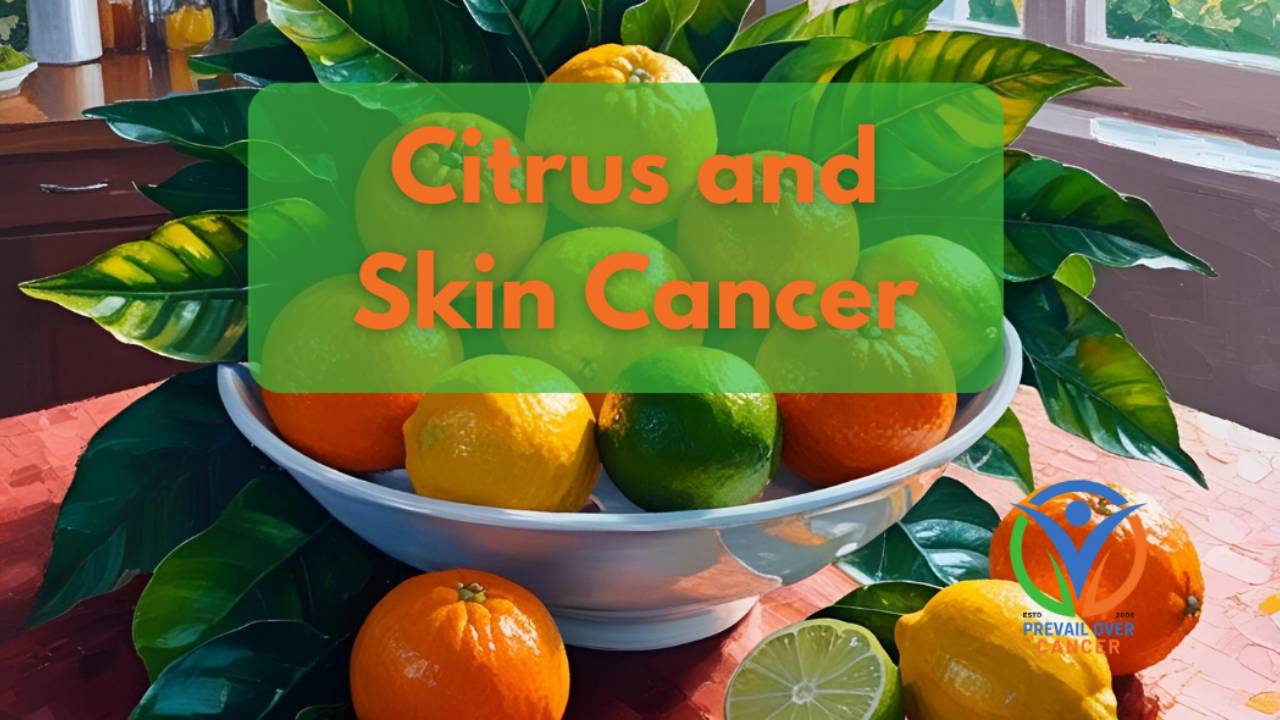The Hidden Skin Cancer Risk of Citrus and Sun Exposure

Researched and written by Keith Bishop, Clinical Nutritionist, Cancer Coach, Retired Pharmacist
Citrus fruits are celebrated for their health benefits, but did you know they might pose a hidden risk when combined with sun exposure? Recent studies have raised concerns about certain compounds in citrus fruits that could increase the risk of skin cancer. Here's what you need to know to stay safe while enjoying the sunshine.
The Cancer Culprit: Psoralens and Furocoumarins
Citrus fruits, such as oranges, lemons, limes, and grapefruits, contain naturally occurring compounds called psoralens and furocoumarins. These compounds are known as photocarcinogens, meaning they can interact with sun ultraviolet (UV) radiation to cause DNA damage in skin cells. This damage may increase the risk of developing skin cancers, including basal cell carcinoma (BCC)[i] [ii] [iii], squamous cell carcinoma (SCC),[iv] and melanoma.[v] One population study found one serving per day of an increase in total citrus or citrus fruit consumption increased the risk of melanoma by 9 - 12%.[vi]
Fair or very fair-skinned people with high citrus consumption have an even higher risk of melanoma.[vii] In one study, researchers found that grapefruit had the most apparent association with the risk of melanoma, which was independent of other lifestyle and dietary factors.[viii]
Why the Skin Cancer Concern?
When psoralens and furocoumarins absorb UV radiation, they become activated and can lead to oxidative stress and DNA mutations in skin cells. Over time, this damage can accumulate, potentially leading to skin cancer. Studies have shown that high consumption of citrus fruits is associated with an increased risk of skin cancers.

Learn How to Select a Quality Dietary Supplement
Practical Tips for Sun Safety
To minimize the risk of skin cancer associated with citrus consumption and sun exposure, consider the following precautions:
- Avoid Citrus Before Sun Exposure: If you plan to spend time outdoors, avoid consuming citrus fruits or juices for a few hours beforehand.
- Consume tea and coffee to reduce skin cancer risks.[ix]
- Cover Up: Wear protective clothing, such as long sleeves and wide-brimmed hats, to shield your skin from UV rays.
- Stay in the Shade: Limit direct sun exposure, especially during peak hours (10 a.m. to 4 p.m.).
By taking these precautions, you can enjoy the benefits of citrus fruits while protecting your skin from potential harm. Stay informed, stay safe, and enjoy the sunshine responsibly!
I don’t eat citrus before going out into the sunshine to work on our property or to ride horses. I take Pathways 2, 3, and 4 before going outside into the sunshine to reduce my risk of sunburn, skin damage, and skin cancer.*
You may use the Discount Code PREVAIL5 at Ultrabotanica and Flourish.
Reference Sources
[i] Mahamat-Saleh, Y., Cervenka, I., Al-Rahmoun, M. et al. Citrus intake and risk of skin cancer in the European Prospective Investigation into Cancer and Nutrition cohort (EPIC). Eur J Epidemiol 35, 1057–1067 (2020). https://doi.org/10.1007/s10654-020-00666-9
[ii] Hezaveh E, Jafari S, Jalilpiran Y, Zargarzadeh N, Mahdavi R, Gargari BP. Dietary components and the risk of non-melanoma skin cancer: A systematic review of epidemiological studies. Crit Rev Food Sci Nutr. 2023;63(21):5290-5305. doi:10.1080/10408398.2021.2016600 https://www.tandfonline.com/doi/10.1080/10408398.2021.2016600?url_ver=Z39.88-2003&rfr_id=ori:rid:crossref.org&rfr_dat=cr_pub%20%200pubmed
[iii] Sun W, Rice MS, Park MK, et al. Intake of Furocoumarins and Risk of Skin Cancer in 2 Prospective US Cohort Studies. J Nutr. 2020;150(6):1535-1544. doi:10.1093/jn/nxaa062 https://pmc.ncbi.nlm.nih.gov/articles/PMC7269730/
[iv] Wu, S., Cho, E., Feskanich, D., Li, W., Sun, Q., Han, J., & Qureshi, A. A. (2015). Citrus consumption and risk of basal cell carcinoma and squamous cell carcinoma of the skin. Carcinogenesis, 36(10), 1162-1168. https://doi.org/10.1093/carcin/bgv109
[v] Melough MM, Wu S, Li WQ, et al. Citrus Consumption and Risk of Cutaneous Malignant Melanoma in the Women's Health Initiative. Nutr Cancer. 2020;72(4):568-575. doi:10.1080/01635581.2019.1644353 https://pmc.ncbi.nlm.nih.gov/articles/PMC6980945/
[vi] Fang X, Han D, Yang J, Li F, Sui X. Citrus Consumption and Risk of Melanoma: A Dose-Response Meta-Analysis of Prospective Cohort Studies. Front Nutr. 2022;9:904957. Published 2022 Jun 20. doi:10.3389/fnut.2022.904957 https://pmc.ncbi.nlm.nih.gov/articles/PMC9251443/
[vii] Marley AR, Li M, Champion VL, Song Y, Han J, Li X. The association between citrus consumption and melanoma risk in the UK Biobank. Br J Dermatol. 2021;185(2):353-362. doi:10.1111/bjd.19896 https://pmc.ncbi.nlm.nih.gov/articles/PMC8373643/
[viii] Wu S, Han J, Feskanich D, et al. Citrus Consumption and Risk of Cutaneous Malignant Melanoma. J Clin Oncol. 2015;33(23):2500-2508. doi:10.1200/JCO.2014.57.4111 https://pmc.ncbi.nlm.nih.gov/articles/PMC4979231/
[ix] Paiva M, Yumeen S, Kahn BJ, et al. Coffee, Citrus, and Alcohol: A Review of What We Drink and How it May Affect our Risk for Skin Cancer. Yale J Biol Med. 2023;96(2):205-210. Published 2023 Jun 30. doi:10.59249/EVKO3455 https://pmc.ncbi.nlm.nih.gov/articles/PMC10303256/



